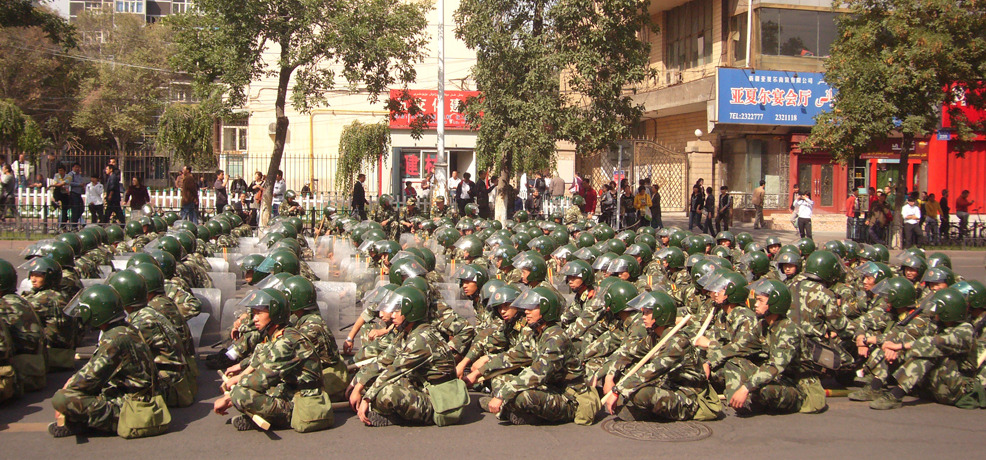
In the spring of 763 CE, eight years of rebellion came to an unceremonious end. The An Lushan Rebellion, started by its namesake, a Chinese general of Turkic descent, sought to carve a new dynasty centered in the Chinese capital of Luoyang to replace the corrupt and decadent Tang Dynasty. Although An Lushan was motivated by personal ambition and not by what we would now classify as ethno-nationalism, the immediate consequences of the rebellion were clear: the Tang turned their backs on the Silk Road-based cosmopolitanism that once defined their glorious empire in favor of homogeneity. The days of rich Persian merchants parading the streets of Guangzhou, of Turkic generals patrolling the northern deserts and of Chinese citizens exploring new cultures in art and expression were long gone. In its place was a new era of mistrust, where Uyghurs (the exact relationship between Tang Dynasty’s Uyghurs and today’s Uyghurs is disputed) were forbidden from wearing their ethnic dress and anti-miscegenation laws were promulgated. The weakened dynasty never regained its glory, leading to a long decline as corruption and rebellions weakened its ranks before ultimately falling in 907.
Recent attacks in Xinjiang, China’s western-most province and home to a prominent Uyghur community, and elsewhere threaten to force a similar pivot to intolerance in contemporary China. The knife attack in Kunming that left 33 dead and the recent market bombing in Urumqi have been met with predictably harsh government reactions. In a spectacular display of political theatrics, the Chinese convicted 55 people of terrorism charges in a mass trial, sentencing three to death and the others to incarceration in front of an audience of 7000.
Though many in the West may label the trial as a typically oppressive action by an authoritarian government, these measures are understandable. The Han majority’s faith in the central government’s ability to protect its own turf from domestic terrorism is waning. The Kunming attack is especially disconcerting, as it took place in a multicultural province where Islam is not the majority religion. To the average Han, the subsequent bombing in volatile Han-majority Urumqi would leave little doubt in the eyes of many Han Chinese that a new era of separatist action was upon them: a new War on Terror must be waged to protect China.
But the mass trial is already a serious blunder on the part of the government. The Uyghurs see the trials as nothing more than the latest in a string of alienating and marginalizing policies. A Han Party Secretary, who takes precedence over a largely symbolic Uyghur governor, rules in the supposedly autonomous Uyghur Province. In everyday life, Uyghurs experience economic marginalization, denial of opportunity and the destruction of homes and old districts in the name of economic progress. And now, the Uyghur community is being blamed for attacks that many had nothing to do with, harassed by security and facing the ire of their neighbors.
Americans of Middle Eastern descent faced similar experiences in the immediate aftermath of 9/11. Faced with paranoia and a blind hate towards all things Islamic, many Americans faced levels of discrimination from stares at airports to having their fundamental rights blatantly violated. The collapse of trust between citizens took years to recover. However, mistrust and intolerance continue to this day, exacerbated by America’s interventions throughout the Muslim world.
If intolerance spurred by acts of terrorism caused American progress to stumble, then it is sure to threaten geopolitical stability for China, a country with relatively little experience in maintaining a society that is just to citizens of all ethnicities. Ethnic tensions boiled over in 2009 with the Urumqi Riots and relations now between the Han and the Uyghurs can only sour after these attacks and show trials. In the interest of maintaining stability and of ultimately expanding the role Xinjiang can play in China’s domestic and international politics, the Chinese government must resist giving in to short-term interests and sentiments and adopt a longer-term vision for Xinjiang.

Traditionally, the Chinese Communist Party (CCP) has relied on top-down control to preserve stability. During the 1989 Tiananmen Incident, the CCP re-emphasized the fact that national reforms must proceed at the hands and whims of the government. The autonomous ethnic provinces of Xinjiang, Tibet, Ningxia, Inner Mongolia and Guangxi are, contradictory to their name, tightly controlled by the Central state.
However, this approach is no longer viable in Xinjiang. As the world decentralizes and new forces are unleashed on the stage of global politics, non-state movements and actors become better organized and more powerful. East Turkestan is once again in the spotlight because many Turkic minorities do not feel “Chinese,” thanks to cultural, political and economic isolation. “Ethnic harmony,” as promoted by the top-down government, hardly soothes a people without a home.
The government must be prepared to accept that unless some bottom-up policies are allowed to flourish, minorities’ animosity towards the CCP will grow. This mistrust is the basis of the violence and independence movements that fuel those seeking East Turkestan today. The government must take extra care that in curbing terrorism they do not foster the next generation of anti-Han minorities.
In order to achieve a truly stable Xinjiang, China must allow the local population to represent their own localities. Although people’s elections for their own mayors are largely symbolic, since real power resides with the Party Secretary of a region, the Party can still exercise more sensitivity by cultivating talented Uyghurs and allowing them political leeway. Too often, the frontier is seen as a stepping-stone for power-hungry Han officials eager for promotion to the capital. They quickly set to work bulldozing buildings, displacing people and building apartments that no local person can afford, calling it economic progress.
In a broader perspective, as China seeks to reconstruct the Silk Road and once again extend its influence over the steppes, it cannot fully strengthen continental relations without a strong Xinjiang. A strong Xinjiang requires a strong citizenry of Uyghurs, Han, Kazakhs and other ethnicities free to express themselves and honor their heritages while also feeling included in the Chinese state and its destiny. A strong Uyghur citizenry will be eager to serve and represent the country and, since four out of the five Central Asian countries share Turkic cultural and linguistic backgrounds, can find themselves uniquely positioned to build strong ties between their home country and Central Asia. It only makes sense that the Chinese government should actively cultivate and develop the region and its people, to truly make Urumqi into a gateway to Central Asia rather than a slogan claiming it as such.
To truly bring Xinjiang into China’s fold and give the Uyghurs a home in a Chinese nation, “ethnic harmony” is not enough. Acceptance of heterogeneity is the ultimate solution. As radical an idea as it might sound considering the tense environment of contemporary China, it is an idea present even in the annals of Chinese history. Taizong (ruled 626 – 649 CE), the second Tang emperor, is still considered one of the greatest emperors in Chinese history. Taizong himself was not fully Chinese, having been born a quarter Turkic and his wife, the Empress Zhangsun, fully Turkic. He understood the importance of a diverse China, and actively encouraged foreign trade and interaction, even going so far as to promote any man of talent, regardless of whether he was ethnically Chinese or not, thus ushering in an era in which Chinese ships and porcelain could be found as far west as the Horn of Africa and where the influence of the realm could be felt all across the vast steppes into Central Asia and the golden city of Samarkand.
Both the Uyghurs and Han yearn for a stable Xinjiang. For China to truly achieve a prosperous and flourishing society, Xinjiang and the Uyghur community must also be empowered. Reactions to terrorism mustn’t repeat the same mistake of the Tang after the An Lushan Rebellion. Diversity and openness, as in the Taizong years, must be favored over intolerance and marginalization.
The views expressed by the author do not necessarily reflect those of the Glimpse from the Globe staff and editorial board.






